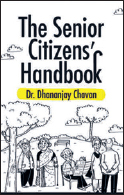Translate this page into:
The Senior Citizens’ Handbook
Corresponding Author:
T Sudhakar Bhat
Near Kayarthodi Temple, Sullia, Karnataka
India
bhat.sudhakar@gmail.com
| How to cite this article: Bhat T S. The Senior Citizens’ Handbook. Natl Med J India 2018;31:315 |
The Senior Citizens’ Handbook. Dhananjay Chavan. Embassy Books, Mumbai, 2018. 160pp, ₹ 195. ISBN 978–93–86450–99–9.

During the years 2000–50, India’s population is expected to increase by 56% while the population aged 60+ years is expected to grow by 326% and that of 80+ years by a whopping 700%. However, the information available for, and attitudes towards the elderly have not shown much change. When I bought a small piece of land for constructing my house a few years before my retirement, a neighbour commented with all seriousness, ‘You have chosen the right place. There is a temple in front and you can spend your days in worshipping and repeating God’s name throughout the day.' Those who were above 60 years of age were not expected to do any useful work. While many illnesses do increase with age, there is increase in the optimism for the aged and the brain growth, and psychological developments are now known to grow beyond 60 years too along with some of the illnesses peculiar to old age. However, there is an information gap on these aspects both among younger adults and the elderly themselves. The current slim volume admirably fills the gap.
The book covers almost the entire range of topics related to ageing. What I liked was that the chapters cover the most essential information and yet are short enough for the elderly to complete a chapter within the shorter attention span which comes with ageing. Twenty-seven topics are covered in nearly 159 pages (excluding the title and contents pages):
- Ageing, age-related decline in sensory and motor functions such as vision, hearing and locomotion
- Common physical symptoms of old age such as constipation, incontinence, dryness of skin and joint pains
- Physical illnesses such as diabetes, hypertension and osteoarthritis
- Psychological aspects such as forgetfulness and dementia
- Social aspects such as loneliness and enforced idling, and religiosity
- Financial and legal aspects important to remember by the aged such as financial planning and taking care to include inflation into the calculations, as well as making a will, and advance directive are discussed. Also included are sensible pieces of advice on hobbies, keeping pets, maintaining a social portfolio and the importance of gratitude for what we have, forgiving instead of continuing with resentments, and practising mindfulness.
While some of the topics are scattered in different chapters because they are common to all of them as the author says, I still wish they were included under one heading while mentioning the other chapter numbers for cross-reference. Some should have been obviously merged (e.g. ‘Some tips for healthy ageing’ and ‘Healthy habits’). ‘Common misconceptions about older adults’ could have come in the beginning, immediately after ‘Ageing process’ instead of at p. 134, after ‘Care of gums and teeth’.
The handbook is useful for senior citizens who can read English, to general practitioners who may not be aware of the legal aspects such as making a will and provision for advance directive, and even to specialists of all specialties who have to deal with the elderly. Advising patients to buy and read it may save several hours of instructions to them during busy consultation hours.
Fulltext Views
1,512
PDF downloads
826




